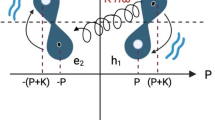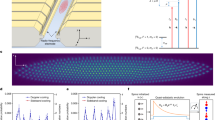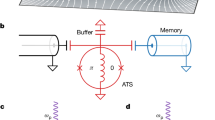Abstract
Ultracold atoms, molecules and ions provide a unique playground to explore chemistry at ultracold temperatures. In this Review, we discuss what makes these systems particularly appealing as controlled quantum systems and the theoretical challenges that their study poses. We discuss recent progress in the field, focusing on chemical processes such as bimolecular chemical reactions, three-body recombination, charge transfer reactions and photochemistry. We emphasize the synergy between theory and experiment, highlighting the predictive power of theory and future directions in ultracold chemistry research.
This is a preview of subscription content, access via your institution
Access options
Access Nature and 54 other Nature Portfolio journals
Get Nature+, our best-value online-access subscription
$29.99 / 30 days
cancel any time
Subscribe to this journal
Receive 12 print issues and online access
$209.00 per year
only $17.42 per issue
Buy this article
- Purchase on Springer Link
- Instant access to full article PDF
Prices may be subject to local taxes which are calculated during checkout






Similar content being viewed by others
References
Brown, R. H. & Twiss, R. Q. Correlation between photons in two coherent beams of light. Nature 177, 27–29 (1956).
Glauber, R. J. Photon correlations. Phys. Rev. Lett. 10, 84–86 (1963).
Getting, I. Perspective/navigation-the global positioning system. IEEE Spectr. 30, 36–38 (1993).
Acín, A. et al. The quantum technologies roadmap: a European community view. New J. Phys. 20, 080201 (2018).
Ludlow, A. D., Boyd, M. M., Ye, J., Peik, E. & Schmidt, P. O. Optical atomic clocks. Rev. Mod. Phys. 87, 637 (2015).
Collaboration, A. Improved limit on the electric dipole moment of the electron. Nature 562, 355–360 (2018).
Roussy, T. S. et al. An improved bound on the electron’s electric dipole moment. Science 381, 46–50 (2023).
Häffner, H., Roos, C. & Blatt, R. Quantum computing with trapped ions. Phys. Rep. 469, 155–203 (2008).
Ebadi, S. et al. Quantum phases of matter on a 256-atom programmable quantum simulator. Nature 595, 227–232 (2021).
Wurtz, J. et al. Aquila: QuEra’s 256-qubit neutral-atom quantum computer. Preprint at https://arxiv.org/abs/2306.11727 (2023).
Cornish, S. L., Tarbutt, M. R. & Hazzard, K. R. A. Quantum computation and quantum simulation with ultracold molecules. Nat. Phys. https://doi.org/10.1038/s41567-024-02453-9 (2024).
Doyle, J., Friedrich, B., Krems, R. V. & Masnou-Seeuws, F. Quo vadis, cold molecules? Eur. Phys. J. D 31, 149–164 (2004).
Krems, R. V. Molecules near absolute zero and external field control of atomic and molecular dynamics. Int. Rev. Phys. Chem. 24, 99–118 (2005).
Krems, R. V. Cold controlled chemistry. Phys. Chem. Chem. Phys. 10, 4079–4092 (2008).
Carr, L. D., DeMille, D., Krems, R. V. & Ye, J. Cold and ultracold molecules: science, technology and applications. New J. Phys. 11, 055049 (2009).
Tomza, M. et al. Cold hybrid ion-atom systems. Rev. Mod. Phys. 91, 035001 (2019).
Pérez-Ríos, J. An Introduction to Cold and Ultracold Chemistry: Atoms, Molecules, Ions and Rydbergs (Springer, 2020).
Deiß, M., Willitsch, S. & Hecker Denschlag, J. Cold trapped molecular ions and hybrid platforms for ions and neutral particles. Nat. Phys. https://doi.org/10.1038/s41567-024-02440-0 (2024).
Craddock, A. N. et al. Quantum interference between photons from an atomic ensemble and a remote atomic ion. Phys. Rev. Lett. 123, 213601 (2019).
Bissbort, U. et al. Emulating solid-state physics with a hybrid system of ultracold ions and atoms. Phys. Rev. Lett. 111, 080501 (2013).
Bell, M. T. & Softley, T. P. Ultracold molecules and ultracold chemistry. Mol. Phys. 107, 99–132 (2009).
Qum´éner, G. & Julienne, P. S. Ultracold molecules under control! Chem. Rev. 112, 4949–5011 (2012).
Balakrishnan, N. Ultracold molecules and the dawn of cold controlled chemistry. J. Chem. Phys. 145, 150901 (2016).
Krems, R., Friedrich, B. & Stwalley, W. E. Cold Molecules: Theory, Experiment, Applications (CRC Press, 2009).
Yan, Z. Z. et al. Resonant dipolar collisions of ultracold molecules induced by microwave dressing. Phys. Rev. Lett. 125, 063401 (2020).
Ospelkaus, S. et al. Quantum-state controlled chemical reactions of ultracold potassium-rubidium molecules. Science 327, 853–857 (2010).
Devolder, A., Brumer, P. & Tscherbul, T. V. Complete quantum coherent control of ultracold molecular collisions. Phys. Rev. Lett. 126, 153403 (2021).
Hu, M.-G. et al. Nuclear spin conservation enables state-to-state control of ultracold molecular reactions. Nat. Chem. 13, 435–440 (2021).
Soley, M. B. & Heller, E. J. Classical approach to collision complexes in ultracold chemical reactions. Phys. Rev. A 98, 052702 (2018).
Greene, C. H., Rau, A. & Fano, U. General form of the quantum-defect theory. II. Phys. Rev. A 26, 2441 (1982).
Seaton, M. Quantum defect theory. Rep. Prog. Phys. 46, 167 (1983).
Mies, F. H. A multichannel quantum defect analysis of diatomic predissociation and inelastic atomic scattering. J. Chem. Phys. 80, 2514–2525 (1984).
Gao, B., Tiesinga, E., Williams, C. J. & Julienne, P. S. Multichannel quantum-defect theory for slow atomic collisions. Phys. Rev. A 72, 042719 (2005).
Gronowski, M., Koza, A. M. & Tomza, M. Ab initio properties of the NaLi molecule in the a3Σ+ electronic state. Phys. Rev. A 102, 020801 (2020).
Idziaszek, Z. & Julienne, P. S. Universal rate constants for reactive collisions of ultracold molecules. Phys. Rev. Lett. 104, 113202 (2010).
Ni, K. K. et al. A high phase-space-density gas of polar molecules. Science 322, 231–235 (2008).
Żuchowski, P. S. & Hutson, J. M. Reactions of ultracold alkali-metal dimers. Phys. Rev. A 81, 060703 (2010).
Ni, K.-K. et al. Dipolar collisions of polar molecules in the quantum regime. Nature 464, 1324–1328 (2010).
Liu, Y. et al. Precision test of statistical dynamics with state-to-state ultracold chemistry. Nature 593, 379–384 (2021).
Takekoshi, T. et al. Ultracold dense samples of dipolar RbCs molecules in the rovibrational and hyperfine ground state. Phys. Rev. Lett. 113, 205301 (2014).
Molony, P. K. et al. Creation of ultracold 87Rb133Cs molecules in the rovibrational ground state. Phys. Rev. Lett. 113, 255301 (2014).
Guo, M. et al. Creation of an ultracold gas of ground-state dipolar 23Na87Rb molecules. Phys. Rev. Lett. 116, 205303 (2016).
Park, J. W., Will, S. A. & Zwierlein, M. W. Ultracold dipolar gas of fermionic 23Na40K molecules in their absolute ground state. Phys. Rev. Lett. 114, 205302 (2015).
Son, H., Park, J. J., Ketterle, W. & Jamison, A. O. Collisional cooling of ultracold molecules. Nature 580, 197–200 (2020).
Valtolina, G. et al. Dipolar evaporation of reactive molecules to below the Fermi temperature. Nature 588, 239–243 (2020).
Matsuda, K. et al. Resonant collisional shielding of reactive molecules using electric fields. Science 370, 1324–1327 (2020).
Li, J.-R. et al. Tuning of dipolar interactions and evaporative cooling in a three-dimensional molecular quantum gas. Nat. Phys. 17, 1144–1148 (2021).
Schindewolf, A. et al. Evaporation of microwave-shielded polar molecules to quantum degeneracy. Nature 607, 677–681 (2022).
Yang, H. et al. Observation of magnetically tunable Feshbach resonances in ultracold 23Na40K + 40K collisions. Science 363, 261–264 (2019).
Yang, H. et al. Evidence for the association of triatomic molecules in ultracold 23Na40K+ 40K mixtures. Nature 602, 229–233 (2022).
Son, H. et al. Control of reactive collisions by quantum interference. Science 375, 1006–1010 (2022).
Su, Z. et al. Resonant control of elastic collisions between 23Na40K molecules and 40K atoms. Phys. Rev. Lett. 129, 033401 (2022).
Mayle, M., Ruzic, B. P. & Bohn, J. L. Statistical aspects of ultracold resonant scattering. Phys. Rev. A 85, 062712 (2012).
Mayle, M., Quéméner, G., Ruzic, B. P. & Bohn, J. L. Scattering of ultracold molecules in the highly resonant regime. Phys. Rev. A 87, 012709 (2013).
Rice, O. K. & Ramsperger, H. C. Theories of unimolecular gas reactions at low pressures. J. Am. Chem. Soc. 49, 1617 (1927).
Kassel, L. S. Studies in homogeneous gas reactions. J. Chem. Phys. 32, 225 (1928).
Eyring, H. The activated complex and the absolute rate of chemical reactions. J. Chem. Phys. 3, 107 (1935).
Marcus, R. A. Unimolecular dissociations and free radical recombination reactions. J. Chem. Phys. 20, 359 (1952).
Christianen, A., Zwierlein, M. W., Groenenboom, G. C. & Karman, T. Photoinduced two-body loss of ultracold molecules. Phys. Rev. Lett. 123, 123402 (2019).
Liu, Y. et al. Photo-excitation of long-lived transient intermediates in ultracold reactions. Nat. Phys. 16, 1132 (2020).
Gregory, P. D., Blackmore, J. A., Bromley, S. L. & Cornish, S. L. Loss of ultracold 87Rb133Cs molecules via optical excitation of long-lived two-body collision complexes. Phys. Rev. Lett. 124, 163402 (2020).
Christianen, A., Karman, T. & Groenenboom, G. C. Quasiclassical method for calculating the density of states of ultracold collision complexes. Phys. Rev. A 100, 032708 (2019).
Gersema, P. et al. Probing photoinduced two-body loss of ultracold nonreactive bosonic 23Na87Rb and 23Na39K molecules. Phys. Rev. Lett. 127, 163401 (2021).
Bause, R. et al. Collisions of ultracold molecules in bright and dark optical dipole traps. Phys. Rev. Res. 3, 033013 (2021).
Croft, J. F. E., Bohn, J. L. & Quéméner, G. Unified model of ultracold molecular collisions. Phys. Rev. A 102, 033306 (2020).
Christianen, A., Groenenboom, G. C. & Karman, T. Lossy quantum defect theory of ultracold molecular collisions. Phys. Rev. A 104, 043327 (2021).
Man, M. P., Groenenboom, G. C. & Karman, T. Symmetry breaking in sticky collisions between ultracold molecules. Phys. Rev. Lett. 129, 243401 (2022).
Quéméner, G., Croft, J. F. & Bohn, J. L. Electric field dependence of complex-dominated ultracold molecular collisions. Phys. Rev. A 105, 013310 (2022).
Jachymski, K., Gronowski, M. & Tomza, M. Collisional losses of ultracold molecules due to intermediate complex formation. Phys. Rev. A 106, L041301 (2022).
Croft, J. F. E., Bohn, J. L. & Quéméner, G. Anomalous lifetimes of ultracold complexes decaying into a single channel. Phys. Rev. A 107, 023304 (2023).
Bause, R., Christianen, A., Schindewolf, A., Bloch, I. & Luo, X.-Y. Ultracold sticky collisions: theoretical and experimental status. J. Phys. Chem. A 127, 729 (2023).
Langen, T., Valtolina, G., Wang, D. & Ye, J. Quantum state manipulation and cooling of ultracold molecules. Nat. Phys. https://doi.org/10.1038/s41567-024-02423-1 (2024).
Suominen, K.-A., Holland, M. J., Burnett, K. & Julienne, P. Optical shielding of cold collisions. Phys. Rev. A 51, 1446 (1995).
Quéméner, G. & Bohn, J. L. Shielding 2Σ ultracold dipolar molecular collisions with electric fields. Phys. Rev. A 93, 012704 (2016).
Karman, T. & Hutson, J. M. Microwave shielding of ultracold polar molecules. Phys. Rev. Lett. 121, 163401 (2018).
Lassablière, L. & Quéméner, G. Controlling the scattering length of ultracold dipolar molecules. Phys. Rev. Lett. 121, 163402 (2018).
González-Martínez, M. L., Bohn, J. L. & Quéméner, G. Adimensional theory of shielding in ultracold collisions of dipolar rotors. Phys. Rev. A 96, 032718 (2017).
Xie, T. et al. Optical shielding of destructive chemical reactions between ultracold ground-state NaRb molecules. Phys. Rev. Lett. 125, 153202 (2020).
Karam, C. et al. Two-photon optical shielding of collisions between ultracold polar molecules. Phys. Rev. Res. 5, 033074 (2023).
Augustovičová, L. D. & Bohn, J. L. Ultracold collisions of polyatomic molecules: CaOH. New J. Phys. 21, 103022 (2019).
Anderegg, L. et al. Observation of microwave shielding of ultracold molecules. Science 373, 779 (2021).
Bigagli, N. et al. Collisionally stable gas of bosonic dipolar ground state molecules. Nat. Phys. 19, 1579–1584 (2023).
Lin, J. et al. Microwave shielding of bosonic NaRb molecules. Phys. Rev. Lett. 13, 031032 (2023).
Bigagli, N. et al. Observation of Bose–Einstein condensation of dipolar molecules. Preprint at https://arxiv.org/abs/2312.10965 (2023).
Huang, S.-J. et al. Field-induced long-lived supermolecules. Phys. Rev. A 85, 055601 (2012).
Avdeenkov, A. V. & Bohn, J. L. Field-linked states of ultracold polar molecules. Phys. Rev. A 69, 012710 (2004).
Quéméner, G., Bohn, J. L. & Croft, J. F. Electro-association of ultracold dipolar molecules into tetramer field-linked states. Phys. Rev. Lett. 131, 043402 (2023).
Chen, X.-Y. et al. Ultracold field-linked tetratomic molecules. Nature 626, 283–287 (2024).
Chen, X.-Y. et al. Field-linked resonances of polar molecules. Nature 614, 59–63 (2023).
Greene, C. H., Dickinson, A. S. & Sadeghpour, H. R. Creation of polar and nonpolar ultra-long-range Rydberg molecules. Phys. Rev. Lett. 85, 2458–2461 (2000).
Hamilton, E. L., Greene, C. H. & Sadeghpour, H. R. Shape-resonance-induced long-range molecular Rydberg states. J. Phys. B 35, L199 (2002).
Bendkowsky, V. et al. Observation of ultralong-range Rydberg molecules. Nature 458, 1005–1008 (2009).
Niederprüm, T. et al. Observation of pendular butterfly Rydberg molecules. Nat. Commun. 7, 12820 (2016).
Giannakeas, P., Eiles, M. T., Robicheaux, F. & Rost, J. M. Dressed ion-pair states of an ultralong-range Rydberg molecule. Phys. Rev. Lett. 125, 123401 (2020).
González-Férez, R., Shertzer, J. & Sadeghpour, H. R. Ultralong-range Rydberg bimolecules. Phys. Rev. Lett. 126, 043401 (2021).
Saßmannshausen, H. & Deiglmayr, J. Observation of Rydberg-atom macrodimers: micrometer-sized diatomic molecules. Phys. Rev. Lett. 117, 083401 (2016).
Zuber, N. et al. Observation of a molecular bond between ions and Rydberg atoms. Nature 605, 453–456 (2022).
Miller, W. H. Theory of Penning ionization. I. Atoms. J. Chem. Phys. 52, 3563–3572 (2003).
Schlagmüller, M. et al. Ultracold chemical reactions of a single Rydberg atom in a dense gas. Phys. Rev. X 6, 031020 (2016).
Kanungo, S. K. et al. Loss rates for high-n, 49 ≲ n ≲ 150, 5sns (3S1) Rydberg atoms excited in an 84Sr Bose–Einstein condensate. Phys. Rev. A 102, 063317 (2020).
Hirzler, H. et al. Controlling the nature of a charged impurity in a bath of Feshbach dimers. Phys. Rev. Res. 2, 033232 (2020).
Pérez-Ríos, J. Cold chemistry: a few-body perspective on impurity physics of a single ion in an ultracold bath. Mol. Phys. 119, e1881637 (2021).
Hirzler, H., Trimby, E., Gerritsma, R., Safavi-Naini, A. & Pérez-Ríos, J. Trap-assisted complexes in cold atom-ion collisions. Phys. Rev. Lett. 130, 143003 (2023).
Pérez-Ríos, Jesús A single ion immersed in an ultracold gas: from cold chemistry to impurity physics. Europhys. News 54, 28–31 (2023).
Pinkas, M., Katz, O., Wengrowicz, J., Akerman, N. & Ozeri, R. Trap-assisted formation of atom–ion bound states. Nat. Phys. 19, 1573–1578 (2023).
Hirzler, H. & Pérez-Ríos, J. Rydberg atom–ion collisions in cold environments. Phys. Rev. A 103, 043323 (2021).
Pérez-Ríos, J. & Greene, C. H. Classical threshold law for ion-neutral-neutral three-body recombination. J. Chem. Phys. 143, 041105 (2015).
Krükow, A. et al. Energy scaling of cold atom-atom-ion three-body recombination. Phys. Rev. Lett. 116, 193201 (2016).
Mohammadi, A. et al. Life and death of a cold BaRb+ molecule inside an ultracold cloud of Rb atoms. Phys. Rev. Res. 3, 013196 (2021).
Pérez-Ríos, J. & Greene, C. H. Universal temperature dependence of the ion–neutral–neutral three-body recombination rate. Phys. Rev. A 98, 062707 (2018).
Mirahmadi, M. & Pérez-Ríos, J. Ion–atom–atom three-body recombination: from the cold to the thermal regime. J. Chem. Phys. 158, 024103 (2023).
Weckesser, P. et al. Observation of Feshbach resonances between a single ion and ultracold atoms. Nature 600, 429–433 (2021).
de Jongh, T. et al. Imaging the onset of the resonance regime in low-energy NO–He collisions. Science 368, 626–630 (2020).
Paliwal, P. et al. Determining the nature of quantum resonances by probing elastic and reactive scattering in cold collisions. Nat. Chem. 13, 94–98 (2021).
Margulis, B. et al. Tomography of Feshbach resonance states. Science 380, 77 (2023).
Tang, G. et al. Quantum state-resolved molecular dipolar collisions over four decades of energy. Science 379, 1031 (2023).
Liu, Y., Grimes, D. D., Hu, M.-G. & Ni, K.-K. Probing ultracold chemistry using ion spectrometry. Phys. Chem. Chem. Phys. 22, 4861–4874 (2020).
Kirste, M. et al. Quantum-state resolved bimolecular collisions of velocity-controlled OH with NO radicals. Science 338, 1060 (2012).
Frye, M. D. & Hutson, J. M. Complexes formed in collisions between ultracold alkali-metal diatomic molecules and atoms. New J. Phys. 23, 125008 (2021).
Frye, M. D. & Hutson, J. M. Long-range states and Feshbach resonances in collisions between ultracold alkali-metal diatomic molecules and atoms. Phys. Rev. Res. 5, 023001 (2023).
Park, J. J. et al. Spectrum of Feshbach resonances in NaLi + Na collisions. Phys. Rev. X 13, 031018 (2023).
Karman, T. et al. Ab initio calculation of the spectrum of Feshbach resonances in NaLi + Na collisions. Phys. Rev. A 108, 023309 (2023).
Park, J. J., Lu, Y.-K., Jamison, A. O., Tscherbul, T. V. & Ketterle, W. A Feshbach resonance in collisions between triplet ground-state molecules. Nature 614, 54–58 (2023).
Safronova, M. S. et al. Search for new physics with atoms and molecules. Rev. Mod. Phys. 90, 025008 (2018).
DeMille, D., Hutzler, N. R., Rey, A. M. & Zelevinsky, T. Quantum sensing and metrology for fundamental physics with molecules. Nat. Phys. https://doi.org/10.1038/s41567-024-02499-9 (2024).
Acknowledgements
We acknowledge discussions at the workshop ‘New directions in cold and ultracold chemistry’ at the Lorentz Center Leiden.
Author information
Authors and Affiliations
Corresponding author
Ethics declarations
Competing interests
The authors declare no competing interests.
Peer review
Peer review information
Nature Physics thanks the anonymous reviewers for their contribution to the peer review of this work.
Additional information
Publisher’s note Springer Nature remains neutral with regard to jurisdictional claims in published maps and institutional affiliations.
Rights and permissions
Springer Nature or its licensor (e.g. a society or other partner) holds exclusive rights to this article under a publishing agreement with the author(s) or other rightsholder(s); author self-archiving of the accepted manuscript version of this article is solely governed by the terms of such publishing agreement and applicable law.
About this article
Cite this article
Karman, T., Tomza, M. & Pérez-Ríos, J. Ultracold chemistry as a testbed for few-body physics. Nat. Phys. 20, 722–729 (2024). https://doi.org/10.1038/s41567-024-02467-3
Received:
Accepted:
Published:
Issue Date:
DOI: https://doi.org/10.1038/s41567-024-02467-3
This article is cited by
-
Cold trapped molecular ions and hybrid platforms for ions and neutral particles
Nature Physics (2024)
-
Quantum state manipulation and cooling of ultracold molecules
Nature Physics (2024)
-
Quantum computation and quantum simulation with ultracold molecules
Nature Physics (2024)



